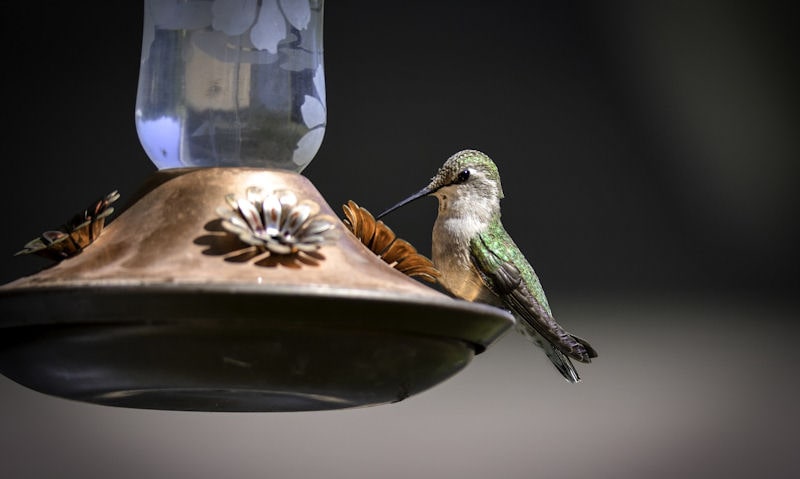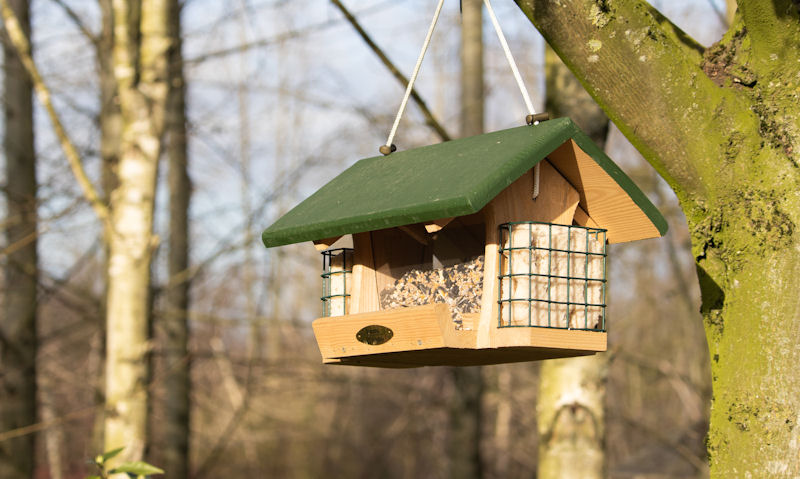How to prepare bird feeder
Preparation of any kind of bird feeder would largely rely on replenishing without spilling, meanwhile you must hang the bird feeder whilst avoiding any additional waste.
How to prepare a bird feeder for hanging would first ensure the bird feeder is fully dry, if you've cleaned it prior to use every time. You will want to keep a seed feeder upright on the ground or surface when replenishing it with seeds to prevent spillages, whilst starting out with quarter capacity bird feed.
While its all okey dory when first getting involved in backyard birding, reality can set in when it comes to finally preparing all types of bird feeders for use in our yards.
Right out of the gate you can expect to make a lot of mess when first replenishing a seed feeder especially, which we feel like a big waste but this can be prevented - or at least dramatically reduced - when planning out a re-filling technique.
With a brand new clean and dry seed feeder in particular, you'd want to stand it upright on the ground so the seeds can be poured in with minimum waste.
Few seeds will spill out of the port wells on the seed feeder but it will only be a handful.
Filling a seed bird feeder on a clean surface could at least call for the spilled seeds to be picked up, so they can be put into the seed feeder as intended.
None of these preparation issues carry over to any other kind of bird feeder, other than any type of seed feeder which does need a little more care and attention.
Preparing a suet feeder is made possible by holding the cage in one hand whilst slotting in the suet cake, or fat balls with the other hand.
Peanuts can be added to a peanut bird feeder similar to how its achieved with a seed feeder, by first placing it upright on the ground or an elevated surface. No peanuts are expected to spill, unless you do without a funnel or bird feed scoop.
As a rule of mine, I never replenish a bird feeder as its still hangs, because not only is it too high off the ground, I just find the angle causes too much bird feed waste.
Bird feeder must be dry
When you first get a brand new bird feeder out of the packaging, with the exception of a nectar Oriole and Hummingbird feeder. It doesn't need to be cleaned prior to use, like how you would with brand new towers, which are put in the laundry prior to use.
Bird feeders are build in a clean environment which will ensure there's no contaminates in the interior or exterior of any kind of feeder.
Regardless, there's no harm in giving a tube seed feeder a clean prior to use to be sure there's no dust or debris in the tube.
Same technique applies to every over kind of bird feeder in use too, it isn't necessary but there's no harm in doing so for the sake of wild birds health.
Deciding to clean the bird feeder in what will probably be in a generic dish soap wash, its vitally important to make sure all bird feeders are fully dried before use. Letting the bird feeder air dry outdoors for a couple of hours will do the trick.
The idea behind making sure all bird feeders are fully dry prior to replenishing it with bird feed, is to first prevent mold forming due to a wet interior manifesting into a bacteria riddled breeding ground - along with bird seeds especially drying up in a hard ball at the base of the tube, which will be difficult to remove later.
Stand upright to insert bird food
First thing we must do before replenishing a seed, peanut or Hummingbird feeder outdoors, is to find what will preferably be a clean level surface to stand a bird feeder in an upright position.
Stand the bird feeder upright on the ground if you like but its a little easier to balance it on a wall or garden furniture, to avoid you personally bending over.
Now I will say I don't recommend putting a bird feeder on the ground generally when it comes to feeding birds - with no real harm when replenishing bird feeders - but do your best to avoid muck sticking to the bird feeder underside.
Bird feeders of all kinds do well to stand upright on a flat surface although there's always a risk of it tipping over.
Be mindful about a bird feeder tipping while replenishing because there's always a chance you will at least accidentally spill it yourself.
When replenishing all bird feeders on the ground it will only be a seed feeder that spills some of its load, of which you mustn't mix spilled ground seeds back into clean, fresh seeds already put in the feeder; as you'd want to look after a birds well being by not adding floor seeds - possibly contaminated with dirt, stones and god knows what.
Believe me when I say, while its safe to put bird seeds on the ground to feed ground feeding birds, you can guarantee one contaminated seed at this stage can spoil your fresh load or seeds, which may need throwing if picking up remnants of bird poop.
Limit bird food to quarter of capacity
In the process of replenishing a seed or peanut bird feeder in particular, its important to first start out by using as little bird feed as possible.
For one thing, as you first utilize bird feeders in your yard there's no telling how much or little wild bird seeds and peanuts will be eaten; as a result you could end up wasting too many seeds, when fewer seeds added to the feeder would of avoided this issue.
What you must do then is continue to replenish a bird feeder with only a quarter of capacity.
No harm at all in underfeeding wild birds as you can simply add more when and if its needed.
To add too many wild bird seed mixes, and peanuts, you can never overfeed birds but you will end up seeing bird food rotting in the feeder. Its easier to keep bad bird feed in a bird feeder longer than it has to be, just in case a little more is eaten.
While this applies largely to seeds and peanuts, waste can apply to adding too many fat balls or suet pellets to a feeder, including dried mealworms and general kitchen scraps which are commonly allowed to go bad on top of a platform feeder.
Clip-shut lid to secure
Now that you are all done replenishing the bird feeders out in the yard, with up to three or four types of bird feed, close each bird feeder shut and hang.
Closing the bird feeder isn't all that hard as you'd simply reserve what you did to open it.
But what's more important is making sure the bird feeder is kept in an upright position at all times, in an effort to prevent bird seed in particular from spilling. Seeds do spill out of their corresponding seed feeder, even if held at a slight angle.
How to use a bird feeder at all times is to fill it up as normal then carefully carry it over to the bird feeder pole or tree branch - wherever you intend to hang the bird feeders - by making sure you don't tip it in the process, which is easy to do.
How to put a bird feeder on a pole bracket would be by holding the bird feeder upright like I said, while simultaneously holding the bird feeder handle/hanger to hook of the bracket hook or hoop, in an effort to prevent you knocking the bird feeder into the pole.
What you are looking to do is to carefully carry any bird feeder as you would, whilst prioritizing its safety as its being carried.
Holding one bird feeder at a time firmly in the hand, while gently hooking it over the branch or bracket, takes a lot of concentration.
Where to position a bird feeder on a pole would be facing out and away from the house, towards the direction of where wild birds fly to your bird feeder location.
Conclusion
Preparation of any type of bird feeder usually comes at the first time you take it out of its packaging, and when replenishing the bird feeders thereafter.
When replenishing a bird feeder every time with fresh, clean bird food like seeds and peanuts, you will want to make sure its nice and dry internally - in an effort to prevent the conditions bacteria will thrive on.
Bone dry bird feeder interior will ensure the bird food will remain fresh for longer.
When you clean a bird feeder - which can be two or three times monthly - you will want to air dry the bird feeder in the sun for two or three hours, whilst keeping the bird feeder upside down, to allow any pockets of moisture to drain.
In the meantime, you will replenish a seed and peanut bird feeder as its stand on the ground or on an elevated surface, in an upright position at all times.
Base of bird feeders tend to be flat to assist in the preparation of adding bird feeder food, although be mindful of any bird feeder standing up like this, will occasionally tip over if you aren't careful.
While avoiding as much bird feed spillage as possible - which is prominent in a seed feeder - you'd only want to add a quarter of its capacity to avoid added too much, in an effort to avoid wasting bird feed which is always left uneaten in the feeders.


